 W
WThe American silver perch, Bairdiella chrysoura, is an American fish. Widespread on the eastern seaboard, the silver perch is commonly caught by inshore anglers in search of larger species. This fish rarely attains 9 inches (230 mm). Silver perch are an underutilized resource as they are excellent table fare and a welcome addition to any Southern fall fish fry.
 W
WAstatotilapia desfontainii is a species of cichlid found in Algeria and Tunisia. It is found in freshwater spring, irrigated land, and canals and ditches. It is threatened by habitat loss. This species reaches a length of 15 centimetres (5.9 in) TL.
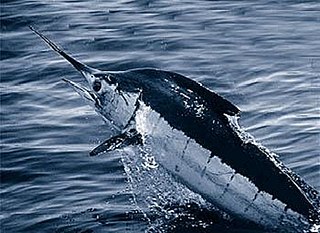 W
WThe Atlantic blue marlin is a species of marlin endemic to the Atlantic Ocean. It is closely related to, and usually considered conspecific with, the Indo-Pacific blue marlin, then simply called blue marlin. Some authorities still consider both species distinct.
 W
WThe Atlantic menhaden is a North American species of fish in the herring family, Clupeidae.
 W
WCheilodipterus macrodon, the large-toothed cardinalfish , is a species of marine fish in the family Apogonidae. It is widespread throughout the tropical waters of the Indo-Pacific region, Red Sea included.
 W
WChlorurus enneacanthus, known commonly as the captain parrotfish, is a species of marine ray-finned fish, a parrotfish from the family Scaridae. It is widespread throughout the tropical waters of the Indian Ocean region. Its range extends from Mozambique to Christmas Island.
 W
WThe leopard coral grouper, also known as the common coral trout, leopard coral trout, blue-dotted coral grouper or spotted coral grouper, is a species of marine ray-finned fish, a grouper from the subfamily Epinephelinae which is part of the family Serranidae, which also includes the anthias and sea basses. It is found in the Western Pacific Ocean.
 W
WEpinephelus flavocaeruleus, commonly called blue-and-yellow grouper, is a species of marine ray-finned fish, a grouper from the subfamily Epinephelinae which is part of the family Serranidae, which also includes the anthias and sea basses. It is associated with reefs in the Indian Ocean.
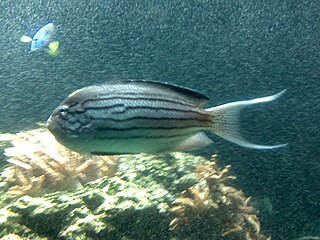 W
WGenicanthus lamarck, commonly called blackstriped angelfish or Lamarck's angelfish among various vernacular names, is a species of marine fish in the family Pomacanthidae.
 W
WGnathodentex is a genus of emperor fish. It is monotypic, being represented by a single species, the goldspot seabream, also known as the striped large-eye bream.
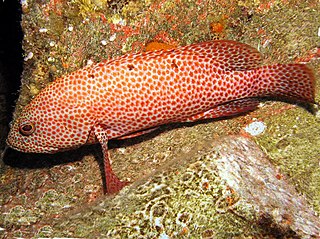 W
WThe graysby is a species of marine ray-finned fish, a grouper from the subfamily Epinephelinae which is in the family Serranidae which also includes the anthias and sea basses. It is found in the western Atlantic. It is associated with reefs and is a quarry species for commercial and recreational fisheries.
 W
WThe largemouth bass is a carnivorous freshwater gamefish in the Centrarchidae (sunfish) family, a species of black bass generally native to eastern and central North America, in Canada, United States and northern Mexico, but widely introduced elsewhere. It is known by a variety of regional names, such as the widemouth bass, bigmouth bass, black bass, bucketmouth, largies, Potter's fish, Florida bass, Florida largemouth, green bass, bucketmouth bass, Green trout, gilsdorf bass, Oswego bass, LMB, and southern largemouth and (paradoxically) northern largemouth. The largemouth bass is the state fish of Georgia and Mississippi, and the state freshwater fish of Florida and Alabama.
 W
WThe leaf scorpionfish or paperfish is a species of marine fish, the sole member of its genus.
 W
WLethrinus lentjan is a species of emperor fish. It has a distinctive blood-red colouration around the margin of the gill covers. It is widespread around the Indo-West Pacific, and is reef-associated. This species is fished commercially and for sport.
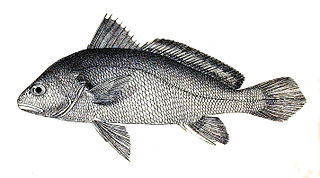 W
WNibea soldado, commonly known as the soldier croaker, is a species of fish native to the northern Indian and western Pacific Oceans, and found in estuaries of south and southeast Asia, Indochina and northern Australia.
 W
WThe ocellaris clownfish, also known as the false percula clownfish or common clownfish, is a marine fish belonging to the family Pomacentridae, which includes clownfishes and damselfishes. Amphiprion ocellaris are found in different colors, depending on where they are located. For example, black Amphiprion ocellaris with white bands can be found near northern Australia, Southeast Asia, and Japan. Orange or red-brown Amphiprion ocellaris also exist with three similar white bands on the body and head. Amphiprion ocellaris can be distinguished from other Amphriphon species based on the number of pectoral rays and dorsal spines. Amphiprion ocellaris are known to grow about 110 mm long. Like many other fish species, females are, however, larger than males. The life cycle of Amphiprion ocellaris varies in whether they reside at the surface or bottom of the ocean. When they initially hatch, they reside near the surface. However, when Amphiprion ocellaris enter into the juvenile stage of life, they travel down to the bottom to find shelter in a host anemone. Once they find their anemone, they form a symbiotic relationship with them.
 W
WThe orange clownfish also known as percula clownfish and clown anemonefish, is widely known as a popular aquarium fish. Like other clownfishes, it often lives in association with sea anemones. A. percula is associated specifically with Heteractis magnifica and Stichodactyla gigantea, and as larvae use chemical cues released from the anemones to identify and locate the appropriate host species to use them for shelter and protection. This causes preferential selection when finding their anemone host species. Although popular, maintaining this species in captivity is rather complex. The Great Barrier Reef Marine Park Authority regulates the number of collection permits issued to aquarium fish dealers who seek this, and other tropical fish within the Great Barrier Reef Marine Park. The symbiosis between anemonefish and anemones depends on the presence of the fish drawing other fish to the anemone, where they are stung by its venomous tentacles. The anemone helps the fish by giving it protection from predators, which include brittle stars, wrasses, and other damselfish, and the fish helps the anemone by feeding it, increasing oxygenation, and removing waste material from the host. Various hypotheses exist about the fish's ability to live within the anemone without being harmed. One study carried out at Marineland of the Pacific by Dr. Demorest Davenport and Dr. Kenneth Noris in 1958 revealed that the mucus secreted by the anemone fish prevented the anemone from discharging its lethal stinging nematocysts. A second hypothesis is that A. percula has acquired immunity towards the sea anemone's toxins, and a combination of the two has been shown to be the case. The fish feed on algae, zooplankton, worms, and small crustaceans.
 W
WOstorhinchus fleurieu is a species of cardinalfish native to the Red Sea and Persian Gulf, the Gulf of Oman, and the waters around East Africa, Seychelles, India, Sri Lanka, the Indo-Malayan region, and Hong Kong., south to the Ashmore Reef, Western Australia. It is the type species of the genus Ostorhinchus. The specific name honours the French explorer and hydrographer Charles Pierre Claret, comte de Fleurieu (1738-1810) who was a colleague and friend of Lacepède's.
 W
WPardachirus marmoratus, also known as the finless sole, the speckled sole or the Red Sea Moses sole, is a small fish from the Red Sea that secretes an ichthyotoxic milky substance from the base of its dorsal and cloacal fins. This secretion contains pardaxin, a lipophillic peptide that causes severe plasma membrane disruption resulting in cell leakage. The pardaxin containing secretion is used as a defensive mechanism against predators including sharks. Pardaxin is irritating to predator fish, particularly affecting the sensitive gills. Dr. Eugenie Clark conducted much of the early work on Pardachirus marmoratus.
 W
WParupeneus heptacanthus, commonly known as cinnabar goatfish, and sold in UK as "Red Mullet", is a marine fish native to the western Pacific and Indian Oceans.
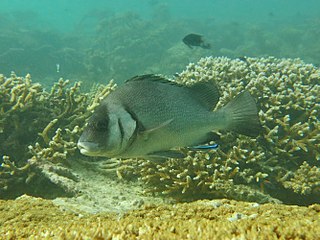 W
WPlectorhinchus gibbosus, commonly known as the Harry sweetlips, is a marine fish native to the Western Pacific and Indian Oceans.
 W
WThe ring-tailed cardinalfish is a widespread fish species in the family Apogonidae found in the Red Sea and off East Africa to Papua New Guinea, north to Japan, and south to Australia.
 W
WKuhlia rupestris, the rock flagtail, jungle perch. mountain trout, buffalo bream, dusky-finned bulleye, rockmountain bass or spotted flagtail, is a species of ray-finned fish, a flagtail, from the family Kuhliidae. It is a catadromous species which is native to the Indo-Pacific and northern Australia.
 W
WSargocentron diadema, known commonly as the crowned squirrelfish, is a member of the family Holocentridae in the order Beryciformes. Squirrelfish in general are large, active, nocturnal fish which are usually red in color.
 W
WScarus frenatus is a species of parrotfish. Common names include bridled parrotfish, sixband or six-banded parrotfish or vermiculate parrotfish.
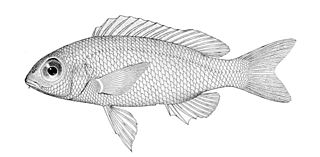 W
WScolopsis ciliata, commonly known as saw-jawed monocle bream, is a fish native to the Indian and Pacific Oceans.
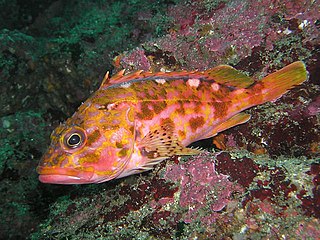 W
WSebastiscus albofasciatus is a species of fish in the rockfish family found in the Western Pacific off the coast of China, Japan, and Korea
 W
WThe smallmouth bass is a species of freshwater fish in the sunfish family (Centrarchidae) of the order Perciformes. It is the type species of its genus. One of the black basses, it is a popular game fish sought by anglers throughout the temperate zones of North America, and has been spread by stocking—as well as illegal introductions—to many cool-water tributaries and lakes in Canada and more so introduced in the United States. The maximum recorded size is approximately 27 inches and 12 pounds. The smallmouth bass is native to the upper and middle Mississippi River basin, the Saint Lawrence River–Great Lakes system, and up into the Hudson Bay basin.The world record size was over 11 pounds caught in the lake Dale Hollow, on the Kentucky—Tennessee border. Its common names include smallmouth, bronzeback, brown bass, brownie, smallie, bronze bass, and bareback bass.
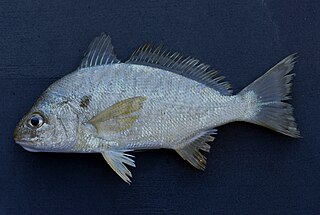 W
WThe Spot or Norfolk spot is a small short-lived saltwater fish in the family Sciaenidae. The species inhabits estuary and coastal waters from Massachusetts to Texas, and derives its name from the prominent dark spot behind each gill. It is the only species in the genus Leiostomus. Spot are frequently caught by recreational anglers and are good to eat.
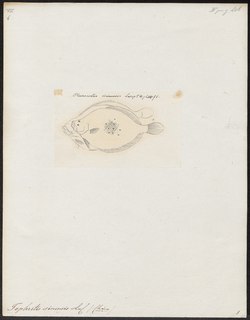 W
WTephrinectes sinensis, the Chinese brill, is a species of flatfish in the large-tooth flounder family, Paralichthyidae. It is the only member of its genus Tephrinectes. Like the rest of the large-tooth flounders, it has both eyes on the left side of its head.
 W
WTephrinectes sinensis, the Chinese brill, is a species of flatfish in the large-tooth flounder family, Paralichthyidae. It is the only member of its genus Tephrinectes. Like the rest of the large-tooth flounders, it has both eyes on the left side of its head.
 W
WThe undulate ray is a species of ray and cartilaginous fish found in the Mediterranean and East Atlantic from southern Ireland and England to the Gulf of Guinea. It is found in areas with mud or sand, and may occur as deep as 200 m (660 ft), though it prefers shallower depths. It is considered endangered due to overfishing.